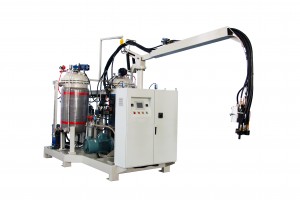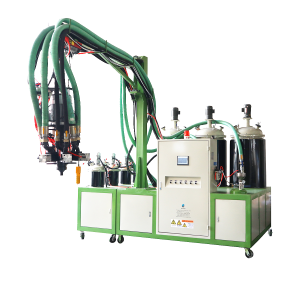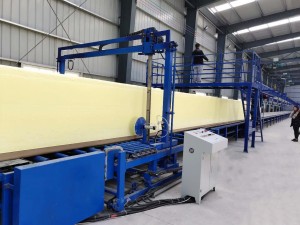Optimize Production Efficiency and Quality of PU Foam Machines: Maintenance Guide and Troubleshooting Tips
As a professional polyurethane equipment manufacturing factory based in China, we understand the importance of maintenance and troubleshooting for PU foam machines. In this article, we will provide you with a maintenance guide and troubleshooting tips to optimize the production efficiency and quality of your PU foam machines. Our comprehensive solutions cover everything from raw materials to finished products, including foam casting machines, foaming machines, foam injection machines, and high-pressure foam machines, catering to various industries such as automotive manufacturing, electronics manufacturing, and machinery manufacturing.
Comparison of PU Foam Machine Technologies
|
Foam Machine Technology Type |
Specific Advantages |
Scope of Application |
| 1. High pressure foam machine | - High-pressure spraying produces a uniform and fine foam coating.- Fast foaming speeds and high productivity- Adjustable spraying parameters and pressure control- Suitable for large coating areas and complex surface geometries. | - Spraying of thermal insulation on walls and roofs- Thermal insulation treatments for commercial and industrial buildings- Automotive interior and seat padding- Thermal insulation treatment for ships and airplanes
- Shipbuilding and aircraft manufacturing |
| 2. Low pressure foam machine | - Filling process controls the density and hardness of the foam- Suitable for the manufacture of parts with complex shapes- Highly controllable foaming parameters and processes- Various foam hardnesses and densities can be realized | - Production of filling and insulating materials- Production of furniture and mattresses- Encapsulation of electronic devices and appliances- Manufacture of packaging and protective materials
- Production of building and decorative materials |
| 3. Continuous production line(Carousel) | - Continuous automated production for increased productivity- Systematic control and monitoring, reducing manual intervention- Customizable line layout and configuration- Rapid switching and adjustment of production processes | - Mass production and continuous production- Demanding quality control and consistency- Production of a wide range of polyurethane products- Production of building materials and insulation
- Automotive and transportation manufacturing |
| 4. Handheld sprayers | - Flexible and lightweight for easy handling and mobility- Ideal for details and hard-to-reach areas- Easy to change nozzles and adjust spraying parameters | - Small and localized area spray treatments- Pipe and duct insulation treatments- Spraying of insulation and sealing materials- Repair and maintenance areas |
Comparison of PU Foam Material Processes
 High-Pressure Mixture Process:
High-Pressure Mixture Process:
Material Preparation: Prepare polyether and isocyanate as the main materials.
High-Pressure Mixing: Inject polyether and isocyanate into a high-pressure mixer for blending. The stirring device in the high-pressure mixer ensures thorough mixing and triggers a chemical reaction.
Mold Filling: Transport the mixture through pipes and fill the mold cavities.
Foaming Reaction: The mixture undergoes a foaming reaction in the mold, generating gas bubbles due to the chemical reaction, filling the entire mold cavity.
Curing and Demolding: After the foaming reaction is complete, the foam material solidifies in the mold and is extracted from the mold using a demolding device.
 Low-Pressure Injection Process:
Low-Pressure Injection Process:
Material Preparation: Prepare polyether, isocyanate, and foaming agents.
Low-Pressure Injection: Inject polyether, isocyanate, and an appropriate amount of foaming agents into the low-pressure injection machine.
Mold Filling: Transport the mixture through pipes and fill the mold cavities.
Foaming Reaction: The mixture undergoes a foaming reaction in the mold, with the foaming agent generating gas bubbles, filling the entire mold cavity.
Curing and Demolding: After the foaming reaction is complete, the foam material solidifies in the mold and is extracted from the mold using a demolding device.
 Continuous Injection Process:
Continuous Injection Process:
Material Preparation: Prepare polyether, isocyanate, and foaming agents.
Continuous Injection: Continuously inject polyether, isocyanate, and an appropriate amount of foaming agents into the mold.
Continuous Foaming Reaction: The mixture undergoes a continuous foaming reaction in the mold, generating gas bubbles, filling the entire mold cavity.
Continuous Curing: While the foaming reaction is ongoing, the foam material continuously cures in the mold.
Continuous Demolding: After the curing is complete, the continuous demolding device extracts the finished PU foam products from the mold.
This detailed list outlines the specific steps involved in PU foam material processes, including foam casting, foaming, foam injection, and high-pressure foam processes, along with their characteristics. Readers can gain insights into the details of different processes and their advantages and applications in various scenarios. This will help readers better understand PU foam material processes, including those performed by PU foam machines, and make informed decisions based on their requirements.
Advantages of PU Foam Machines
1.Improved Production Efficiency:
High-speed mixing and foaming: PU foam machines, including high-pressure foam machines, enable rapid mixing and foaming processes, significantly reducing the production cycle.
Automated operation: Modern PU foam machines, such as foam casting machines and foaming machines, come with automation features that enhance production efficiency and reduce manual intervention.
Optimized Product Quality:
2.Uniformity and consistency:
PU foam machines, including foam injection machines, ensure the even mixing of materials, resulting in consistent quality and performance of the products.
Density and hardness control: The machines offer precise control over foam material density and hardness, catering to different application requirements.
3.Iverse Applications:
Strong adaptability: PU foam machines, including foam casting machines, are versatile and can work with various materials, producing different types of PU materials.
Wide range of industries: PU foam machines find applications in industries such as automotive manufacturing, construction, electronics, furniture, aerospace, and more.
4.Flexibility and Adjustability:
Customizability: PU foam machines, including foaming machines, can be tailored to meet specific customer requirements, allowing for adjustments and configurations.
Multiple production modes: The machines can adapt to different production modes, including high-pressure foam processes, foam injection processes, and more.
5.Environmentally-Friendly and Sustainable:
Waste and energy reduction: PU foam machines, including high-pressure foam machines, minimize waste generation and improve energy utilization efficiency.
Environmental consciousness: PU foam materials produced by these machines can be recycled and reused, aligning with environmental and sustainable development requirements.
6.Technological Innovation and Continuous Development:
Advanced technology application: PU foam machines, including foam casting machines, incorporate advanced control technologies, such as PLC control systems and touchscreen interfaces.
Ongoing research and improvement: Equipment manufacturers continuously engage in research and development to meet evolving market demands and customer requirements.
This comprehensive list highlights multiple advantages of PU foam machines, including foam casting machines, foaming machines, foam injection machines, and high-pressure foam machines, providing specific details and descriptions. These advantages demonstrate the value and benefits of using PU foam machines, including improved production efficiency, optimized product quality, adaptability to various applications, flexibility, environmental friendliness, technological innovation, and continuous development. Readers will gain a comprehensive understanding of the value and advantages of PU foam machines, enabling them to make informed decisions when selecting the right equipment.
FAQs about PU Foam Machines
- Q: Why is my PU foam machine producing uneven spraying?
- A: Possible causes include nozzle clogging, inaccurate material ratios, and inappropriate spraying distance. You can clean the nozzle, adjust material ratios, and ensure the spraying distance is suitable for achieving even spraying.
- Q: What should I do if the foam density produced by my PU foam machine does not meet the requirements?
- A: Foam density can be influenced by factors such as material ratios, foaming time, and temperature. You can check the material ratios, adjust foaming time and temperature to achieve the desired foam density.
- Q: My PU foam machine is producing abnormal noise during operation. How can I resolve this?
- A: Abnormal noise could be caused by loose or worn-out equipment components. You can check the fasteners and parts of the machine, perform necessary adjustments or replacements to eliminate the noise issue.
- Q: I noticed my PU foam machine is leaking. How can I address this?
- A: Leaks can be caused by worn or damaged seals. You can inspect the seals and promptly replace any damaged ones to ensure the machine operates smoothly without any liquid leakage.
- Q: What should I do if my PU foam machine experiences a malfunction?
- A: Malfunctions can have various causes, such as electrical issues or problems with the transmission system. You can start by checking the electrical connections and transmission system of the machine. If there are any issues, contact the equipment manufacturer or professional technicians for further troubleshooting and repairs.
- Q: How do I perform regular maintenance on my PU foam machine?
- A: Regular maintenance is crucial to keeping the PU foam machine in good working condition. You can clean the machine, lubricate moving parts, check electrical connections, and replace worn-out components. Please refer to the machine’s operation manual and maintenance guide, following the recommended maintenance schedule.
- Q: How can I choose the right PU foam machine for my needs?
- A: Selecting the appropriate PU foam machine involves considering factors such as production requirements, product specifications, and budget. You can communicate with equipment manufacturers or professional consultants to understand the advantages of different models and configurations, enabling you to choose the most suitable machine for your needs.
Conclusion:
Maintaining and servicing PU foam machines are critical steps to ensure their smooth operation and optimize production efficiency and quality. By following the maintenance guide and troubleshooting tips provided, you can enhance the production efficiency and quality of your PU foam machine while minimizing the possibility of malfunctions. As a professional manufacturer, we are committed to providing comprehensive pre-sales and after-sales support, including technical assistance, training, and troubleshooting. We look forward to collaborating with you and providing the best solutions for your polyurethane equipment needs!
Post time: Jul-13-2023


